Some handy books for cooking savory pies (and one that is not so handy).
Savory pie has enjoyed a revival of sorts, and, in the United Kingdom (as we still may call it, at least for now) that revival has been reflected in a number of cookbooks.
A parallel if much more modest trend supports a number of outstanding bakers of pie in the United States, notably the Royal Pies of Pleasant House in Chicago and The English Pork Pie Company in Buffalo.
Notwithstanding the new books, a good place for the fledgling piemaker to jump from the nest is a pair of classics from the dawn of the British food revival during the 1970s. Neither is dedicated exclusively to pies; each of them has lots of good ones. Elisabeth Ayrton devotes a chapter in The Cookery of England to “The Tradition of the Savoury Pie .” Mrs. Ayrton charts the history of piemaking in her introduction to the chapter, which runs to thirty-nine pages and includes detailed instructions for making pastry and a number of puddings.
She offers heartfelt reassurance to the novice:
“Do not be afraid of making pastry. It is true that quantities must be fairly accurately measured; butter must never be oiled or even very soft; you must work rather quickly and use your hands lightly and ‘rest’ the dough… ; but on the other hand most pastries take only a few minutes to make and none takes more than half an hour.” (Ayrton 90)
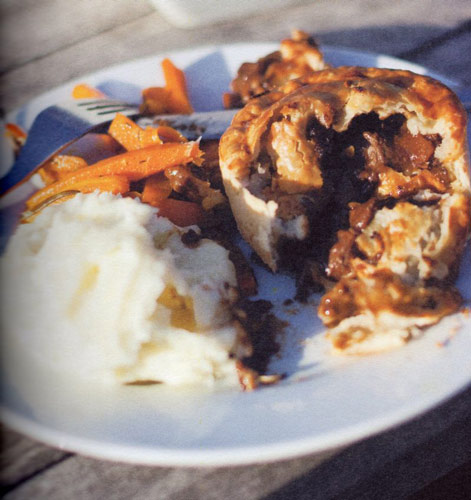
Then Mrs. Ayrton proceeds to offer the best general guidelines in print for making short, puff and raised (or ‘hot water’) pastry; suet pastry and dumplings are so simple it requires no introduction. She also outlines recipes for flaky, milk and cheese pastry before proceeding to the pies themselves. There are forcemeat balls here, for a West Country chicken and steak pie from the nineteenth century, and others, including a good rendition of the iconic steak and kidney that lies midway on the spectrum of complexity. Vegetarians will find a Lenten ‘herb pie’ made with green vegetables and egg.
Raised pies, utterly unique to Britain, get their own subchapter; so do pasties but the few puddings unfortunately are a mere afterthought. The Cookery of England unaccountably is out of print but widely available online from used booksellers.
Jane Grigson, who has no peer among food writers, places her pies in the subsection of a long chapter on meat, poultry and game. Her English Food covers ground similar to The Cookery of England in a different way. She intersperses the recipes with stories from her childhood, anecdotes from history, notes on the origin of recipes (Mrs. Grigson is most generous in attributing recipes to others) and nuanced advice, in recognition that
“ ….there is the question of taste and discretion. If you make a Cornish pastry for a miner to put in his pocket to take to work, the pastry has to be pretty thick, or the whole thing will spoil. If you are making mince pies for the end of a large meal, you will need to roll the pastry thinner than if they are destined to fill up hungry young carol singers. Or you may decide to make a lot of little pork pies rather than one large one, so more pastry will be required.” (Grigson 225)
This kind of modesty and this quality of prose glitters throughout English Food. The recipes, including the ones for pie, are just as clear.
The quality of writing unfortunately has declined summarily since the Age of Grigson. One aspect of this decline is an infatuation with forced informality. The stylistic evolution of Tom Bridge exemplifies the trend. Not that his protean style is particularly good; Bridge is a clumsy writer in any guise.
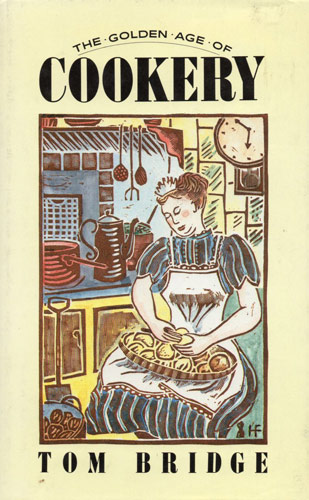
Back in 1983, for example, he aspired to an authoritative tone with The Golden Age of Cookery . It is more than somewhat curious that Bridge locates this apogee in the nineteenth century, when British cooks veered from their indigenous roots in favor of faux French food and other abominations and dishes of any kind tended to get heavier.
According to Bridge,
“ ….many great chefs came to this country in the nineteenth century, such as Escoffier, Carême, Soyer and Brillat-Savarin, who wrote their influence into the cookery books of today. They came here because English food and traditional recipes are worth writing down.” ( Golden Age 1)
Now this is odd. Except for Soyer, none of those men showed much interest in British food and without exception they emigrated to the richest country in the world to exploit the demand for French, not English, chefs and their food. Nor, again other than Soyer, did they ‘write an English influence’ into their predictably French cookbooks.
Bridge goes on to describe a “golden era when food was not frozen, pre-packed or convenience food.” ( Golden Age 1) This era is largely fictive. Food may not have been frozen, but by the second half of the century it certainly and prevalently was canned. British cooks took to cans with fervor for their convenience; canned meat, canned fruit, canned vegetables, canned pies and stews, canned soup. Escoffier even advised his reader not to attempt turtle soup because it was easier to open a can of the stuff.
It is perhaps most astonishing when Bridge claims “[t]he British have a great love of food, with a home-bred tradition that the Europeans are now following.” ( Golden Age 1) ‘The Europeans’ like food no less than the British or anybody else; various European countries had developed a range of sophisticated cuisines long before the nineteenth let alone twentieth century; and by then the British “home bred tradition” already had begun the fast fade that would begin to reverse only during the 1970s.
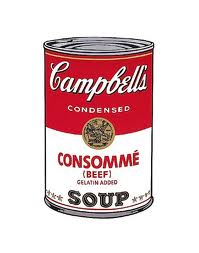
Despite the robust British tradition of savory pies, they do not figure much in The Golden Age of Cookery , which incidentally and despite Bridge’s assurance does not identify the source of all its recipes .
In 2010, Bridge rectified the omission and changed his style with Pie Society. By then Bridge had decided to become a sort of good-humored and enthusiastic friend of his reader, so jokey asides and exclamation points abound. Some of the book therefore sounds inane. One example: “The following stocks and methods are taken from my 200 Classic Sauces Cookbook --a bit of recipe recycling that shows that I really do waste nothing!” ( Pie Society 45)
This is not a question of waste but rather, if you purchased the earlier book, of diminished value for money.
Not just this kind of recycling but also this kind of self-promotion mar Pie Society. Bridge has taken the slightest excuse to reinforce his sponsorships (he assiduously advertises Grant’s canned haggis throughout the book), public profile, from his appearances on television and hosting of food festivals to his acquaintance with industry insiders and B-List celebrities (Tom Hix, Madhur Jaffrey, the Earl of Bradford, Lily Allen…).
Bridge would style himself a scholar: “As a food historian I couldn’t resist this recipe” for “Beef Korma Curry Pies.” He gives no source for the recipe, however, none of the books listed in his bibliography dates to 1865, the Editor has found no such early recipe for a pie filled with curry from so early a date and in any event, as indicated by The Golden Age of Cookery , his historical judgment is unsound.
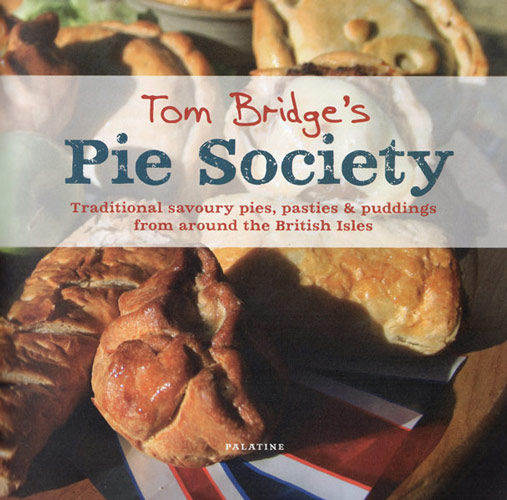
The index is inadequate and the editing sloppy. The ‘story of Porter’s restaurant’ (universally derided by critics other than Bridge), for instance, appears at page 167, not 160 as he notes.
But no matter. Soldier past the serial annoyances (“have a go… ” is a favorite phrase; “Twenty-first Century Pie, or ‘The Credit Munch’!”; “Actually I’m being a bit naughty here…. ”; “Cheesy eggy stuff!”) to examine some good excerpts from historical sources including the inimitable Dr. Kitchiner and Florence White.
The recipes themselves are mercifully free of the fluff that surrounds them. Instead Bridge has written them in practical language and presented their steps in logical sequence. No padding here either; Bridge has included a lot of accessible and appealing recipes for savory pies. The cooking component of the marketing package that Pie Society otherwise represents is superb.
Appealing pies include a rabbit and crayfish [sic] one generously attributed to Hix; a good take on shepherds’ pie; an Edwardian beef and quail pudding (savory puddings get a dedicated chapter of Pie Society ); four distinct variations on the classic steak and kidney; and an original beef and haggis in puff pastry, Beef Wellington made Scottish through replacement of foie gras with the haggis to coat the beef.
Angela Boggiano is, according to Pie , “an experienced writer and food stylist based in London.” As such she has inadvertently reinforced our preconception that style and substance seldom manage to coexist. Pie is a pretty book loaded with lavish photographs--at least half its pages have no print--that depict delightful dishes, an exemplar of the fashion for food porn. It also is loaded with good ideas and bad recipes. Nobody actually can have cooked many of them as written, because the proportions given are skewed to the point of comedy.
Too much lemon overwhelms the flavor of everything else in the recipe for asparagus turnovers made with cheeses and ham; pastry quantities can be risibly wrong, like the amount specified for the ‘pear frangipane croustade.’ Stick with Bridge and his banter instead.
Tristan Hogg and Jon Simon banter like Bridge, and affect a similarly humorous tone, but somehow in their hands the conceit rings true; a pulled pork pie, for instance, is “perfect for those among us who own tractors and pigs.” ( Pieminister 116)
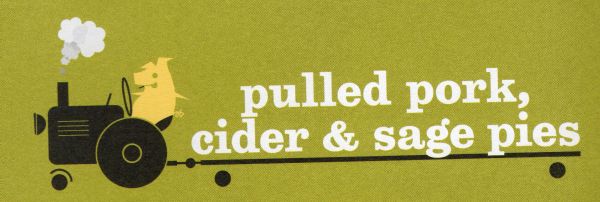
Their loopy personalities inhabit their book, Pieminister: a pie for all seasons , to render it genuine. Another example:
“Sometimes we change names because we don’t like the original ones, and here is a textbook example. ‘Finger food’ sounds gruesome, ‘canapes’ sound pansy, but canapies sound tasty!” ( Pieminister 188)
Hogg and Simon founded the redoubtable Pieminister bakery in Bristol during 2003. Branches subsequently have blossomed throughout the British Isles and across the Channel in Amsterdam without any discernable decline from an extremely high level of quality. Pieminister operates thirteen farmers’ market stalls and eleven of its own restaurants as well as selling its pies from at least eleven public houses.
Each excellent pie has a silly name (except for Kate & Sidney, straight Cockney rhyming slang) and Pieminister packaging features whimsical graphics including its mascot, a winsome (pie) bird, of course.

Pieminister’s pie bird in Spring
The cookbook, which first appeared in 2011 and remains in print, self-consciously reflects the times in its seasonal format, guide to foraging as well as influences from India, the Americas (there is more than that pulled pork), and entire Mediterranean rim, but Pieminister pies also can be creative in the British idiom. Fresh horseradish grated into traditional suet pastry provides steak and kidney pie or pudding with a pungent pop; clapshot improves the traditional topping of potatoes alone over shepherd’s pie which, after all, originated in Scotland, although the seasoning of soy sauce is more traditional than most might think.
Despite the playful innovations, Pieminister hardly turns its back on tradition. A pie for Easter includes the anchovies and artichokes that would have joined the lamb as late as the eighteenth century, while smoked haddock pie made with cider is a classic.
You will want accents to accompany your pie and Pieminister provides them along with a “booze matching” chart. John Evelyn would have recognized the herb salad (but unfortunately described as “Arabic-style”) in Restoration England and a “sweet chilli [sic; Hogg and Simon are British of course and so is their usage] crème fraiche is, as they claim, good alongside “summery pies and also great with trashy (yet delicious) food such as crisps, burgers and fish fingers.” ( Pieminister 209) Fun.
Two years after Pieminister blasted into British kitchens, Dorling Kindersley published Pies sweet and savory by Caroline Bretherton. It is a perplexing effort. The prose is awkward throughout, the book repetitive, some of its content gratuitous and much of the text banal.
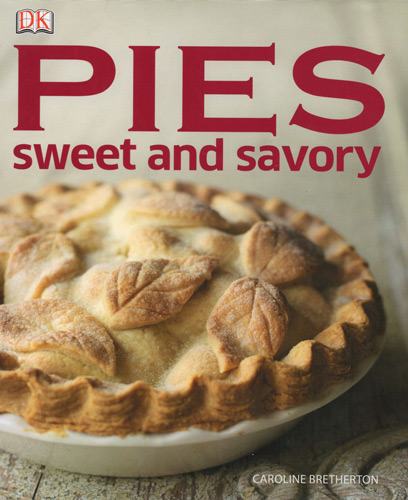
To introduce one recipe, Bretherton shares the incisive insight that “[a]fter a festive meal there are sometimes more leftovers than you know what to do with.” In case anyone missed the point, she repeats it on the following page: “Traditionally, both a turkey and a ham are served on or around Christmas day, which can leave you with a lot of meaty leftovers.” ( Pies 97, 98) Still on the subject of Christmas, she explains that “[s]ometimes simple entertaining dishes are what’s required, but it’s nice to spend a little more time producing something special.” ( Pie 96) This kind of thing lacks purpose or conviction. It is nothing but fatuous padding.
The same lavish full-page color photographs also appear more than once but some pies get no photograph at all.
For three similar pies--steak & ale, steak & mushroom, steak & kidney--Bretherton specifies three different cuts of beef without either explanation or purpose. Is she hoping to render the recipes from Pies more various than in fact they are? The reliance on all manner of dairy from milk, half-and-half, cream, sour cream and crème fraiche to cottage cheese appears similarly gratuitous and also deadening; it creates more than a few overly rich pies.
Some selections and omissions are merely curious. Why include recipes for curried vegetables and, of all things, mussels but nothing else remotely Indian except vegetable samosas?
If Pies is sloppy and lacks a certain soul, however, it is a decent cookbook despite the flaws and would be a welcome addition to the collection of a novice piemaker. The recipes are clear and the instruction gentle. A fifteen page chapter on making pastry offers not only illustrated, step-by-step guides to making a dozen different crusts from hot water paste to strudel, but also a note on baking blind and recommended decoration techniques.
Inexplicably, this chapter on the foundation of making pies does not appear until page 104 and, its title, “In Praise of Pie Dough,” seems more than a little silly in a book called Pies.
But the selection of recipes is catholic, and welcome. Not many people look to Finland for their food but Bretherton includes a couple of distinctive Finnish pies. A sort of German pizza topped with melting onion, sour cream (of course), bacon and caraway hits good notes. Unlike most books on baking, Pies refuses to sideline fish with its twenty-five recipes, including some obscure British renditions that deserve revival, an appealing anchovy tart and Bretherton’s creative if, again, rich smoked trout tart bound with egg and crème fraiche.
In the end the fault with Pies lies with her editors as much as with Bretherton herself, and her intention does not seem so bad. Besides, notwithstanding its international outlook, her book embodies British food in America: Bretherton is a Londoner living in North Carolina.
Tamasin Day-Lewis establishes a different kind of Anglo-American connection in Tarts with Tops On or How to Make the Perfect Pie. Day-Lewis, member of the storied British family (her father was Poet Laureate and her brother is Daniel), gives American pies a chapter all her own, even if none of them is savory.
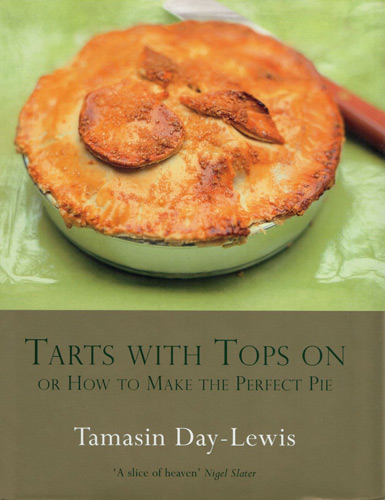
The allusive title is overcute and also gratuitous; the introduction that plays upon it labored; and the division of pies into ‘savory’ and ‘traditional’ is odd given the pies in the savory category, which include British mainstays like Forfar bridies, their bigger cousin the Welsh chicken and leek pie, “Somerset Pork Pie with Cider and Apples,” cottage pie and shepherds’ pie.
Day-Lewis takes aim at a purely English audience, and despite its inclusion of ‘foreign’ pies, in culinary terms Tarts with Tops boasts a beating heart of oak, as the introduction to the chapter “Traditional Pies” indicates:
“In England we have the pie and we have roasting. We are--or can be--exceptionally good at both. So let us get to work on the traditional pies…. Let us sing their praises and rediscover them. It is not all about raised hot water crusts and suet puddings, though they are the definition of comfort food. These are the sort of pies we should be putting back on the table with a flourish and no apologies. They are our heritage and none the less for it.” ( Tarts 49)
So be not deterred by its fripperies. Tarts is a serious book with an important manifesto after all.
Day-Lewis leads her traditional chapter with steak and kidney pie, the only perfect choice. Hers is likeable enough, if not as likeable as the one from the Guinea in Mayfair. Tarts rounds up the usual welcome suspects, raised pies, Cornish pasties and the like, along with some lost wonders; the Cornish charter and an “utterly droolworthy” pie of mutton or lamb with capers and mushrooms, even if unaccountably seasoned with tarragon (Day-Lewis likes tarragon) instead of the essential rosemary. ( Tarts 62)
No plagiarism for Day-Lewis. Where appropriate she identifies the source of each pie both within and outside a chapter called “Other People’s Pies.” Richard Guest, for example, gets credit for the mutton and caper pie in the traditional chapter. More of the usual suspects are Other People; Sally Clarke, Richard Corrigan (his grouse en croute is indeed delectable, but try getting grouse or a mortgage to cover its cost), Simon Hopkinson, Claudia Roden, Michel Roux, Nigel Slater and a few sleepers too.
Foremost among these underpublicized masters must be the self-effacing, brilliant and original Stephen Markwick, a most welcome addition to this pantheon of sorts.
Writing about another of Day-Lewis’ books in The Spectator , Elfreda Pownall predicted that “[y]ou will be cooking from it for years to come.” This continues to be the case in the Editor’s kitchen for Tarts with Tops On over a decade past its introduction in 2003.

